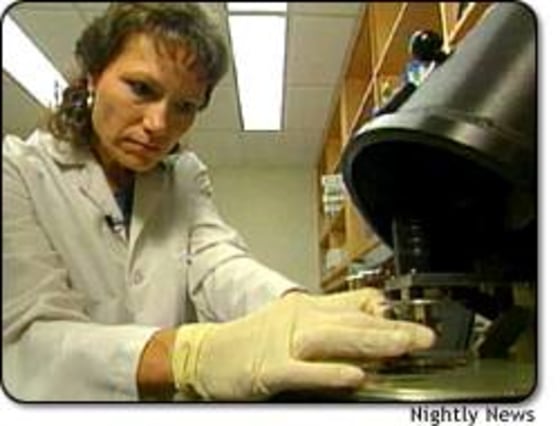Sensors that light up within seconds after coming into contact with a dangerous virus or bacteria may allow emergency workers in the field to quickly detect any weapons of bioterrorism, researchers say.
In a study appearing this week in the journal Science, researchers at Massachusetts Institute of Technology say they have engineered cells that are able to sense and identify bioweapons spread through the mails, air, or water.
The system uses mouse B lymphocytes, or white blood cells, that have been engineered to contain a jellyfish gene for a luminescent protein and altered to carry antibodies that respond to specific diseases.
When antibodies on the sensor cells detect a pathogen, such as anthrax, they trigger a burst of calcium within the B cells. Within seconds, the calcium activates the bioluminescent protein and causes the whole cell to glow. This is a signal that the specimen has a dangerous germ.
The system would not require advanced training to operate, in contrast to current lab techniques that are performed by highly trained scientists or technicians.
“It is very simple to operate,” said Todd H. Rider, an MIT researcher and first author of the study. “The B cells do all the hard work. Nature has designed them to detect bacteria and viruses.”
In the body, B cells are a major part of the immune system. Different B cells carry antibodies that recognize and adhere to specific bacteria or viruses.
SYSTEM WORKS IN SECONDS
Rider said the system, developed with funding from the Defense Advanced Research Projects Agency, has been tested successfully against all of the known pathogens that can be used for bioweapons, including anthrax, smallpox, plague, tularemia and encephalitis.
Using the system, emergency responders could test suspicious substances on the street or in subways or airports, he said.
“If you have a white powder, for instance, you could add it to the sensor and it would be analyzed within a few seconds,” he said.
Right now, emergency workers often have to take a sample of the suspicious substance to a laboratory for tests.
“The existing techniques take at least a half hour to several hours,” said Rider. “This system works in 30 seconds to three minutes.”
The B cells could be housed in a closed, lightproof box equipped with an electronic light sensing unit, Rider said. If a biological sample inserted into the box gives off a sudden brightening from the bioluminescence of the B cells, the light sensor would detect the change and send a signal to a gauge or dial or laptop computer.
Rider said the MIT researchers are developing a way to use biosensors as “sniffers” to test for airborne pathogens. He said the technique could be used in subways, buildings or airports, all prime targets for bioterrorists.
TESTING FOOD AND WATER
In tests, the biosensor system quickly identified the presence of a disease-causing form of E. coli, a bacteria that can be a major cause of food poisoning. Rider said the system was sensitive enough to identify the E. coli strains that are pathogenic, or disease-causing, and to ignore those that are not hazardous. This suggests that the biosensors could used by inspectors to test food and water.
Eventually, said Rider, a version of the test could be developed for use in a doctor’s office.
“Perhaps you could cough on something and wait a few seconds to find out what you have,” said Rider. This would enable physicians, for instance, to immediately identify patients who have severe acute respiratory syndrome, or SARS, and those just infected with a cold.
Rider is the inventor of the technique and patent holder of record, although MIT has principal ownership. He said the university plans to license the technology so that practical systems can be developed for general use. Rider said he could personally benefit economically from the licensing.
